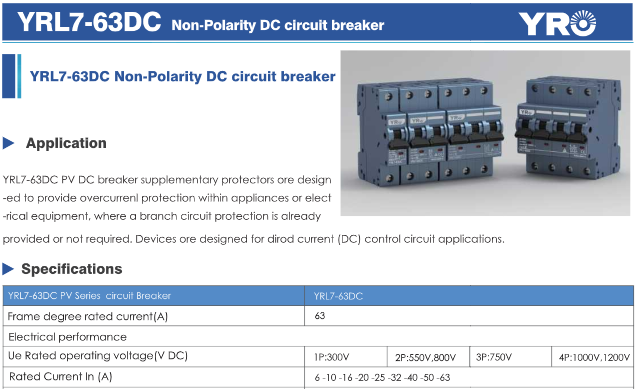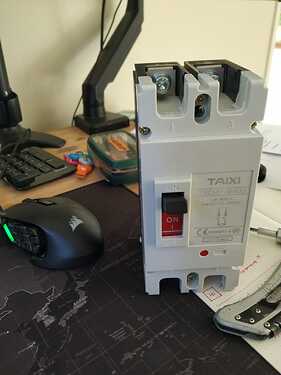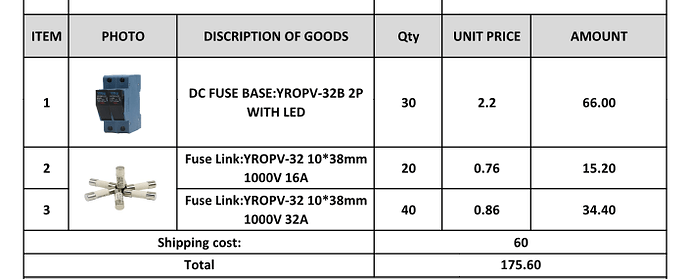So do you mean they should be orientated towards the side where its protecting from the fault. So from busbar to mppt should be the orientation not the other way round which is the flow of current from mppt to busbar?
It’s entirely possible that a breaker wired incorrectly would develop carbon on the contacts after the first trip (because the arc was not properly quenched), and due to the damage it would now trip earlier and easier. At lower voltages, you might get away with an incorrectly wired breaker without the big fire as in that video.
When wiring polarised breakers, you have to think which side is MORE positive/negative. If the breaker is between the MPPT and the battery, then the MPPT is MORE positive than the battery, so the positive of the MPPT goes to the + side, and the positive of the battery towards the -. Conversely, the negative side of the MPPT is more negative than the battery, so the negative of the MPPT goes to the - terminal, while the negative of the battery goes to the opposing + terminal.
The confusing part is that from the battery perspective, it now seems to be the wrong way around… but it is actually correct.
For a breaker between the inverter and the battery… well you’re kinda screwed. That part is bi-directional…
Edit: @Phil.g00 makes a good point too. If the fault is on the “wrong” side and the current is going the other way, you’re screwed either way. In this case, the voltage also plays a role. With roughly 50V on the battery side, the arc will quench a lot easier than with the 200V-ish in many PV arrays. Probably still best to orientate it according to that, right?
I think one day I will just get some fused dis-connectors for my mppt to battery, problem solved.
Faults are possible on all parts of the circuit.
On the battery, on the busbars, on the panels, on the inverters.
Protection design involves drawing the circuit and applying a theoretical fault on all sections of the circuit and ensuring that something will interupt all power sources.
Fuses and bi-directional MCBs are the way to go.
But when we are considering a un-earthed DC circuit only the + or only the - leg needs to be interrupted to clear a short-circuit.
Hint: Therein lies the solution to making those MCBs bi-directional. (But good luck getting it signed off).
I get what you saying, but if there are fuses between battery and busbar then the breaker doesnt need to handle the fault currrent on the busbar as the battery fuses will do that, it just needs to handle any upstream faults from the bus bar to the mppt. I do agree that fuses will be a much better option to cover all round.
You do get non-/ bidirectional DC breakers. Noark makes some, quite expensive.
If you have to make do, also think about the fallout of a fault. Your battery can dump a much larger fault current than the MPPT can, so when things go wrong, which side are you more worried about? As @plonkster says, the voltage plays a role, but you’ll make a much bigger hole dead-shorting the battery than the MPPT, even on the same wire.
But the correct answer is a fuse in this case or a non- / bidirectional breaker.
I use fuses on everything and then where I would potentially want to switch things off easily (when working on the setup for instance) I also add breakers.
So I have breakers to disconnect the PV panels and also to disconnect the battery, but they also have fuses as well (fuse is cheap most of the time)
thanks for all the replies, some really good feedback.
Don’t say I told you, but if you wire say the positive leg the right way through one pole of that MCB and then wire it the wrong way through the other pole, it will be bi-directional and clear a short-circuit in either direction.
Just be sure the MCB voltage rating is more than double of the circuit.
I suspect the voltage rating will suffer a bit though. The total voltage is usually the sum of the two “gaps”, but by having one the wrong way around that side will have a lower voltage rating. But for your Noark breakers with a 500VDC rating, you’ll probably be fine if you’re protecting the average blue MPPT… limited to 250V on the PV side.
I beat you to it.
I’ve been sitting here wondering how the bidirectional ones work, but this is surely it. And the price increase comes from the lowered rating which has to be brought back up. Nice.
1000Vdc - cheap as chips:
You seem to be one of the very few people on this forum who also like Aliexpress ![]()
My current paperweight and fidget-toy (decided against batteries for the time being):
Makes a satisfying click.
99% of things come from that direction anyway.
It’s just that where I am now, I will actually receive parcels in the post.
I am not so sure I’d be that keen on Aliexpress if I was in ZA.
I went for these at 250A:
And a 400A NH2 fuse in series, to be sure, to be sure.
That’s for each battery bank. Then because I’ll have a 3ph system with a big Victron/phase, I picked up this AC/DC monster cheap secondhand.
I was thinking I don’t want to be messing with this sending a wire through 2 poles to be bidirectional, I may just as well just get fuses for my panel strings.
The plan for the MPPTs was to parallel strings on the roof until just sub 30A max and then bring a pair of 6mm wires and the through a pair of fuses, combine again with other pair(s) and off to the MPPT solar inputs.
And I’d use the same fuse-holders with 16A fuses for the PV inverter strings.
So off to Alibaba to get quotes. None of the venders could beat this Aliexpress quote:
But one vendor was offering fuses holders with LEDs that showed the circuit to be live.
( You shouldn’t pull the fuses under load). So I liked this touch.
It was a fair quote for the LED type, so now I was going to buy these:
“Am I going to pay now, sir”
I say hold on, send me your catalogue, I might want something else, he does that.
I end up buying these instead of the fuses:
I chose 550V rated for the MPPT in feeds, 800V rated for the PV inverters.

This was the quote:

Shipping was $50 dollars, but I thought this was a very good price for non-directional MCBs.
I couldn’t find any on Aliexpress. If anyone is interested, I’ll say which company, (if I receive them in good order).
Edit: The unspecified prices are in USD.
I was thinking… again.
A battery MCB, well it must afford bi-directional protection. This is to protect against internal faults from the busbar and external faults on the cabling to the busbar. Convention dictates it is connected to the battery terminal(s).
But, what about that spanner that drops across the batteries?
Well, the bi-directional MCB ( fed from the busbar) will trip sure, but you could still be left with half a battery pack shorted feeding the fault.
Besides fusing every battery I don’t think you can cover every eventuality.
But can you get some form of improvement relatively cheaply? I mean you literally have nothing covering this fault.
I think these cheap directional MCBs (or even a single fuse) can still have a place in battery protection if they are used in the correct orientation at the battery midpoint.
If you have a 16S bank then correctly orientated between cells 8 & 9. I haven’t seen this done before, but it may have merit. (Cell 1 being the + terminal say)
Thoughts anyone?
Many lithium packs essentially have that with a built-in breaker just before the pack output, from where you parallel and then add the “actual” fuses.
So it feels like that should work, as long as your balancer can see “past” the fuse or breaker, i.e. at the cells, which is always the case for lithium, and they’re in the parallelling position.
I wouldn’t do that with lead-acid, since you could create quite the imbalance with the variability between fuses. Same for midpoint somewhere in a series config?
Are you referring to a potential volt drop on the MCB or fuse which now forms the busbar between cell 8 and 9?
I don’t think it would bother Lead acid HA02 balancers sice they have 2 discrete balancing leads ber battery busbar. However I think the Litium BMSs only have a single balance lead per busbar and a choice would have to be made if a single fuse was used.



